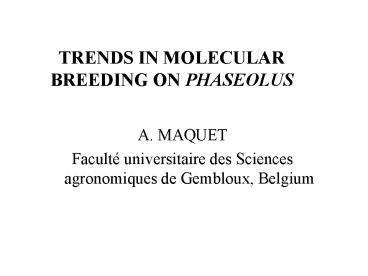A' MAQUET - PowerPoint PPT Presentation
1 / 11
Title:
A' MAQUET
Description:
To establish genetic relationships between the Phaseolus species. To tag more easily polygenic characters ... Drought, Heat, CBB, Leafhopper, Bruchid. P. acutifolius ... – PowerPoint PPT presentation
Number of Views:463
Avg rating:3.0/5.0
Title: A' MAQUET
1
TRENDS IN MOLECULAR BREEDING ON PHASEOLUS
A. MAQUET Faculté universitaire des Sciences
agronomiques de Gembloux, Belgium
2
Molecular markers, Genome mapping
Marker-assisted selection in beans
- To establish genetic relationships between the
Phaseolus species - To tag more easily polygenic characters
- To hasten the transfer of desirable genes among
varieties - To introgress novel genes from related wild
species
3
Schematic representation of the different gene
pools of the five cultivated species of Phaseolus
beans (after D. Debouck)
P. lunatus
P. vulgaris
GP2
P. costaricensis
P. polyanthus
GP4
P. coccineus
GP1
GP3
P. acutifolius
4
Gene pools of P. vulgaris (after D. Debouck)
P. cos P. costaricensis P. pol P.
polyanthus P. cocc P. coccineus P. acu P.
acutifolius P. par P. parvifolius P. fil P.
filiformis.
5
Sources in related Phaseolus species of some
useful traits deficient in P. vulgaris (after
S.P. Singh)
6
Remarks
- Current limitations
- Post-fertilisation events
- Sterility of hybrid plants
- Traditional chromosome doubling yield
semi-fertile amphidiploids - Transferring polygenically inherited traits from
related species to P. vulgaris met limited
success - Current accomplishment
- lt5 of Phaseolus germplasm used in hybridisation
programmes - Congruity backcrossing and recurrent selection
- Availability of molecular markers, development of
linkage maps, marker-assisted selection
7
Linkage maps in common bean
- Several linkage maps were developed
- The parents belong to different gene pools
(Mesoamerican and Andean) - Total map length appears to be close to 1,200 cM
- A core mapping population (cross BAT93 x Jalo
EEP558) integrates mapping information - 550 molecular markers, mainly RFLP and RAPD
markers, were mapped in this RI population
consisting of 11 linkage groups
8
Applications of these linkage maps
- Comparative mapping in the Phaseoleae tribe
- No unified Phaseoleae genome as the grass genome
- A unified Phaseolinae genome (i.e. common bean,
cowpea, mungbean) can be constructed - Mapping genes for phenotypic traits
- 15 major disease resistance genes tagged by 23
RAPD and 5 SCAR - Multigene family for arcelin mapped to linkage
group 4 - Genes coding for several morphological (ie seed
and flower colours, absence of pod fibres) and
physiological (photoperiod sensitivity) traits
were also mapped
9
Applications of these linkage maps (continued)
- Analysis of the domestication syndrome and gene
introgression - Simple genetic control
- Existence of major genes and high heritability of
several components - Recovering a domesticated phenotype in the
progeny of wild x domesticated crosses should be
easy - Dissection of complex traits
- QTL analyses have been performed for disease
resistances (ie. CBB, web blight), Rhizobium
nodulation, plant architecture, canning quality,
and drought tolerance
10
Applications of these linkage maps (continued)
- Marker-assisted selection (MAS)
- With the identification of molecular markers
linked to resistance genes in P. vulgaris, MAS in
disease resistance breeding is possible - Opportunity to pyramid genes waiting until the F4
generation to screen lines for linked markers - Pyramiding diverse resistance genes using MAS are
carried out for Anthracnose, BCM, Bean rust, and
BGM - Efforts to utilize MAS for the improvement of
quantitative traits have been limited (ie. BGM,
CBB)
11
Look to the future
- Molecular systematic
- Mechanisms of genetic incompatibility
- Efficient and reproducible system of regeneration
- Increase the genome coverage to attach all
unassigned markers developing new mapping
populations - Pursue the mapping of major genes and QTLs for
agronomic traits - Interest to sequence the Phaseolus genome































